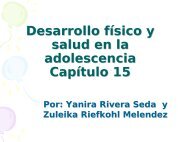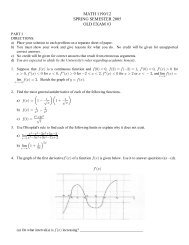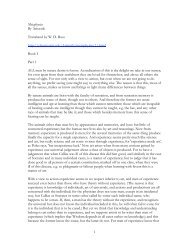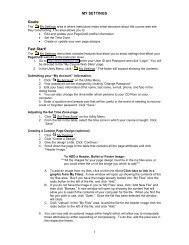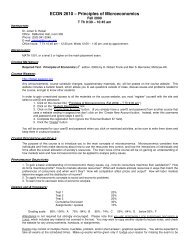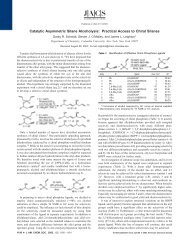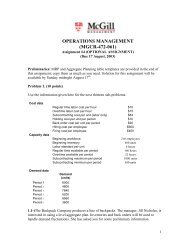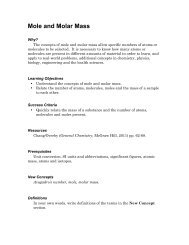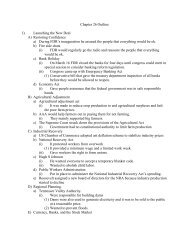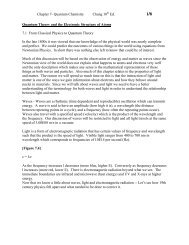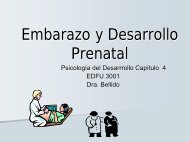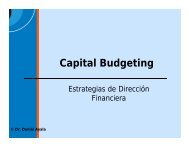GENERAL ACCOUNTING SECTION 1540 cash flow ... - PageOut
GENERAL ACCOUNTING SECTION 1540 cash flow ... - PageOut
GENERAL ACCOUNTING SECTION 1540 cash flow ... - PageOut
You also want an ePaper? Increase the reach of your titles
YUMPU automatically turns print PDFs into web optimized ePapers that Google loves.
The CICA Official Pronouncements Collection<br />
<strong>GENERAL</strong> <strong>ACCOUNTING</strong><br />
<strong>SECTION</strong> <strong>1540</strong><br />
<strong>cash</strong> <strong>flow</strong> statements<br />
TABLE OF CONTENTS Paragraph<br />
Purpose and scope .01-.05<br />
Definitions .06<br />
Cash and <strong>cash</strong> equivalents .07-.11<br />
Classification of <strong>cash</strong> <strong>flow</strong>s .12-.19<br />
Operating activities .15-.17<br />
Investing activities .18<br />
Financing activities .19<br />
Cash <strong>flow</strong>s from operating activities .20-.22<br />
Cash <strong>flow</strong>s from investing and financing activities .23-.24<br />
Cash <strong>flow</strong>s on a net basis .25-.27<br />
Foreign currency <strong>cash</strong> <strong>flow</strong>s .28-.31<br />
Extraordinary items .32-.33<br />
Interest and dividends .34-.37<br />
Income taxes .38-.39<br />
Investments in equity accounted investees and<br />
joint ventures<br />
Business combinations and disposals of business<br />
units<br />
.40-.41<br />
.42-.45<br />
Non-<strong>cash</strong> transactions .46-.47<br />
Disclosure of <strong>cash</strong> and equivalents .48-.52<br />
Transitional provisions .53-.55<br />
Cash <strong>flow</strong> statements for an enterprise other than<br />
a financial institution<br />
Appendix A<br />
Cash <strong>flow</strong> statements for a financial institution Appendix B<br />
The CICA Virtual Professional Library 2003
The CICA Official Pronouncements Collection<br />
Purpose and Scope<br />
TABLE OF CONTENTS Paragraph<br />
PURPOSE AND SCOPE<br />
.01 Information about the <strong>cash</strong> <strong>flow</strong>s of an enterprise enables users of financial statements to<br />
assess the capacity of the enterprise to generate <strong>cash</strong> and <strong>cash</strong> equivalents and the needs<br />
of the enterprise for <strong>cash</strong> resources. The adequacy of expected <strong>cash</strong> in<strong>flow</strong>s, taking into<br />
consideration their timing and certainty of generation, is evaluated against <strong>cash</strong> resources<br />
required to repay maturing financial obligations, to finance the growth of productive<br />
assets and to make distributions to owners. Historical <strong>cash</strong> <strong>flow</strong> information is often used<br />
as an indicator of the amount, timing and certainty of future <strong>cash</strong> <strong>flow</strong>s. The purpose of<br />
this Section is to require the provision of information about the historical changes in <strong>cash</strong><br />
and <strong>cash</strong> equivalents of an enterprise by means of a <strong>cash</strong> <strong>flow</strong> statement which classifies<br />
<strong>cash</strong> <strong>flow</strong>s during the period arising from operating, investing and financing activities.<br />
.02 This Section does not apply to pension plans (see PENSION PLANS, Section 4100) nor<br />
to not-for-profit organizations (see FINANCIAL STATEMENT PRESENTATION BY<br />
NOT-FOR-PROFIT ORGANIZATIONS, Section 4400). In addition, this Section need<br />
not be applied to an investment fund that meets all of the following criteria:<br />
(a) during the period, substantially all of the investment fund's investments were highly<br />
liquid;<br />
(b) substantially all the investment fund's investments are carried at market value (as<br />
defined in FINANCIAL INSTRUMENTS - DISCLOSURE AND PRESENTATION,<br />
Section 3860);<br />
(c) the investment fund has little or no debt based on average debt outstanding during the<br />
period, in relation to total assets; and<br />
(d) the investment fund provides a statement of changes in net assets.<br />
An investment fund that presents a <strong>cash</strong> <strong>flow</strong> statement would follow the<br />
Recommendations of this Section.<br />
.03 ♦ A <strong>cash</strong> <strong>flow</strong> statement should be presented as an integral part of the financial<br />
statements for each period for which financial statements are presented, unless the<br />
reporting enterprise is not a public enterprise 1(1) and the required <strong>cash</strong> <strong>flow</strong><br />
information is readily apparent from the other financial statements or is adequately<br />
disclosed in the notes to the financial statements. When a <strong>cash</strong> <strong>flow</strong> statement is not<br />
presented, the reason should be disclosed. [AUGUST 1998]<br />
.04 Users of an enterprise's financial statements are interested in how the enterprise generates<br />
and uses <strong>cash</strong> and <strong>cash</strong> equivalents. This is the case regardless of the nature of the<br />
enterprise's activities and irrespective of whether <strong>cash</strong> can be viewed as the product of<br />
the enterprise, as may be the case with a financial institution. 2(2) When an enterprise<br />
The CICA Virtual Professional Library 2003
The CICA Official Pronouncements Collection<br />
which is not a public enterprise has relatively simple operations with few or no<br />
significant financing and investing activities and the required <strong>cash</strong> <strong>flow</strong> information is<br />
readily apparent from the other financial statements and notes to the financial statements,<br />
the presentation of <strong>cash</strong> <strong>flow</strong>s in a financial statement format would not be necessary.<br />
.05 An enterprise which presents consolidated financial statements includes a consolidated<br />
<strong>cash</strong> <strong>flow</strong> statement, in which <strong>cash</strong> <strong>flow</strong>s within the consolidated entity, such as<br />
inter-company loans, repayments and other <strong>cash</strong> transfers, are eliminated.<br />
Definitions<br />
DEFINITIONS<br />
.06 The following terms are used in this Section with the meanings specified:<br />
Cash and <strong>cash</strong> equivalents<br />
(a) Cash comprises <strong>cash</strong> on hand and demand deposits.<br />
(b) Cash equivalents are short-term, highly liquid investments that are readily<br />
convertible to known amounts of <strong>cash</strong> and which are subject to an insignificant risk<br />
of changes in value.<br />
(c) Cash <strong>flow</strong>s are in<strong>flow</strong>s and out<strong>flow</strong>s of <strong>cash</strong> and <strong>cash</strong> equivalents.<br />
(d) Operating activities are the principal revenue-producing activities of the enterprise<br />
and all other activities that are not investing or financing activities.<br />
(e) Investing activities are the acquisition and disposal of long-term assets and other<br />
investments not included in <strong>cash</strong> equivalents.<br />
(f) Financing activities are activities that result in changes in the size and composition<br />
of the equity capital and borrowings of the enterprise.<br />
Cash and <strong>cash</strong> equivalents<br />
.07 Cash subject to restrictions that prevent its use for current purposes, such as<br />
compensating balances required in accordance with lending arrangements, would not be<br />
included among <strong>cash</strong> and <strong>cash</strong> equivalents. Cash subject to restrictions would be<br />
classified on the balance sheet in accordance with CASH, Section 3000 and increases and<br />
decreases would be reflected in <strong>cash</strong> <strong>flow</strong>s from investing activities.<br />
.08 Cash equivalents are held for the purpose of meeting short-term <strong>cash</strong> commitments rather<br />
than for investing or other purposes. For an investment to qualify as a <strong>cash</strong> equivalent it<br />
must be readily convertible to a known amount of <strong>cash</strong> and be subject to an insignificant<br />
risk of changes in value. Therefore, an investment normally qualifies as a <strong>cash</strong> equivalent<br />
only when it has a short maturity of, say, three months or less from the date of<br />
acquisition. Equity investments are excluded from <strong>cash</strong> equivalents.<br />
.09 In certain circumstances, investments that qualify to be treated as <strong>cash</strong> equivalents may<br />
be classified as trading assets or investments. An enterprise would establish a policy<br />
concerning which short-term, highly liquid investments, that satisfy the definition in<br />
The CICA Virtual Professional Library 2003
The CICA Official Pronouncements Collection<br />
paragraph <strong>1540</strong>.06, will be treated as <strong>cash</strong> equivalents. For example, a bank may decide<br />
that all investments that qualify except those purchased for its trading account will be<br />
treated as <strong>cash</strong> equivalents, while an investment enterprise, whose portfolio consists<br />
largely of short-term, highly liquid investments, may decide that all such items will be<br />
treated as investments rather than <strong>cash</strong> equivalents.<br />
.10 Bank borrowings are generally considered to be financing activities. However, in some<br />
cases, bank overdrafts which are repayable on demand form an integral part of an<br />
enterprise's <strong>cash</strong> management. Bank overdrafts may be included as a component of <strong>cash</strong><br />
and <strong>cash</strong> equivalents when the bank balance fluctuates frequently from being positive to<br />
overdrawn.<br />
.11 Cash <strong>flow</strong>s exclude movements between items that constitute <strong>cash</strong> or <strong>cash</strong> equivalents<br />
because these components are part of the <strong>cash</strong> management of an enterprise rather than<br />
part of its operating, investing and financing activities.<br />
Classification of Cash Flows<br />
CLASSIFICATION OF CASH FLOWS<br />
.12 ♦ The <strong>cash</strong> <strong>flow</strong> statement should report <strong>cash</strong> <strong>flow</strong>s during the period classified by<br />
operating, investing and financing activities. [AUGUST 1998]<br />
.13 An enterprise presents its <strong>cash</strong> <strong>flow</strong>s from operating, investing and financing activities in<br />
a manner which is most appropriate to its business. Classification by activity provides<br />
information that allows users to assess the impact of those activities on the financial<br />
position of the enterprise and the amount of its <strong>cash</strong> and <strong>cash</strong> equivalents. This<br />
information may also be used to evaluate the relationships among those activities.<br />
.14 A single transaction may include <strong>cash</strong> <strong>flow</strong>s that are classified differently. For example,<br />
when the <strong>cash</strong> repayment of a liability includes both interest and principal, the interest<br />
component is classified as an operating activity and the principal component as a<br />
financing activity.<br />
Operating activities<br />
Operating activities<br />
.15 The amount of <strong>cash</strong> <strong>flow</strong>s arising from operating activities is a key indicator of the extent<br />
to which the operations of the enterprise have generated sufficient <strong>cash</strong> <strong>flow</strong>s to repay<br />
loans, maintain the operating capability of the enterprise, make new investments and<br />
provide distributions to owners without recourse to external sources of financing.<br />
Information about the specific components of historical operating <strong>cash</strong> <strong>flow</strong>s is useful, in<br />
conjunction with other information, in forecasting future operating <strong>cash</strong> <strong>flow</strong>s.<br />
.16 Cash <strong>flow</strong>s from operating activities are primarily derived from the principal<br />
revenue-producing activities of the enterprise. Therefore, they generally result from the<br />
transactions and other events that enter into the determination of net income or loss.<br />
Examples of <strong>cash</strong> <strong>flow</strong>s from operating activities are:<br />
The CICA Virtual Professional Library 2003
The CICA Official Pronouncements Collection<br />
(a) <strong>cash</strong> receipts from the sale of goods and the rendering of services;<br />
(b) <strong>cash</strong> receipts from royalties, fees, commissions and other revenue;<br />
(c) <strong>cash</strong> payments to suppliers for goods and services;<br />
(d) <strong>cash</strong> payments to and on behalf of employees;<br />
(e) <strong>cash</strong> receipts and payments of interest and dividends included in the determination of<br />
net income;<br />
(f) <strong>cash</strong> receipts and payments of an insurance enterprise for premiums and claims,<br />
annuities and other policy benefits;<br />
(g) <strong>cash</strong> payments and refunds of income and other taxes; and<br />
(h) <strong>cash</strong> receipts and payments from contracts held for trading purposes.<br />
Some transactions, such as the sale of a capital asset, may give rise to a gain or loss<br />
which is included in the determination of net income or loss. However, the <strong>cash</strong> <strong>flow</strong>s<br />
relating to such transactions are <strong>cash</strong> <strong>flow</strong>s from investing activities.<br />
.17 An enterprise may hold securities and loans for trading purposes, 3(3) in which case they<br />
are similar to inventory acquired specifically for resale. Therefore, <strong>cash</strong> <strong>flow</strong>s arising<br />
from the purchase and sale of trading assets are classified as operating activities.<br />
Investing activities<br />
Investing activities<br />
.18 The separate disclosure of <strong>cash</strong> <strong>flow</strong>s arising from investing activities is important<br />
because the <strong>cash</strong> <strong>flow</strong>s represent the extent to which expenditures have been made for<br />
resources intended to generate future income and <strong>cash</strong> <strong>flow</strong>s. Examples of <strong>cash</strong> <strong>flow</strong>s<br />
arising from investing activities are:<br />
(a) <strong>cash</strong> payments to acquire capital assets and other long-term assets. These payments<br />
include those relating to capitalized development costs and self-constructed capital<br />
assets including interest paid and capitalized before the assets are substantially<br />
complete and ready for productive use;<br />
(b) <strong>cash</strong> receipts from sales of capital assets and other long-term assets;<br />
(c) <strong>cash</strong> payments to acquire equity or debt instruments of other enterprises and interests<br />
in joint ventures (other than payments for those instruments considered to be <strong>cash</strong><br />
equivalents or those held for trading purposes);<br />
(d) <strong>cash</strong> receipts from sales of equity or debt instruments of other enterprises and<br />
interests in joint ventures (other than receipts for those instruments considered to be<br />
<strong>cash</strong> equivalents and those held for trading purposes);<br />
(e) <strong>cash</strong> advances and loans made to other parties;<br />
(f) <strong>cash</strong> receipts from the repayment of advances and loans made to other parties;<br />
The CICA Virtual Professional Library 2003
The CICA Official Pronouncements Collection<br />
Financing activities<br />
(g) <strong>cash</strong> payments for futures contracts, forward contracts, option contracts and swap<br />
contracts except when the contracts are held for trading purposes, or the payments are<br />
classified as financing activities; and<br />
(h) <strong>cash</strong> receipts from futures contracts, forward contracts, option contracts and swap<br />
contracts except when the contracts are held for trading purposes, or the receipts are<br />
classified as financing activities.<br />
When a contract is accounted for as a hedge of an identifiable current or anticipated<br />
position, the <strong>cash</strong> <strong>flow</strong>s of the contract may be classified in the same manner as the <strong>cash</strong><br />
<strong>flow</strong>s of the position being hedged provided that this accounting policy is disclosed.<br />
Financing activities<br />
.19 The separate disclosure of <strong>cash</strong> <strong>flow</strong>s arising from financing activities is important<br />
because it is useful in predicting claims on future <strong>cash</strong> <strong>flow</strong>s by providers of capital and<br />
debt financing to the enterprise. Examples of <strong>cash</strong> <strong>flow</strong>s arising from financing activities<br />
are:<br />
(a) <strong>cash</strong> proceeds from issuing equity instruments;<br />
(b) <strong>cash</strong> payments to owners to acquire or redeem the enterprise's shares;<br />
(c) <strong>cash</strong> proceeds from issuing debentures, loans, notes, bonds, mortgages and other<br />
short- or long-term borrowings including deposits accepted by a financial institution;<br />
(d) <strong>cash</strong> repayments of amounts borrowed;<br />
(e) <strong>cash</strong> payments by a lessee for the reduction of the outstanding liability relating to a<br />
capital lease; and<br />
(f) <strong>cash</strong> payments of dividends and interest charged to retained earnings.<br />
Cash Flows from Operating Activities<br />
CASH FLOWS FROM OPERATING ACTIVITIES<br />
.20 ♦ An enterprise should report <strong>cash</strong> <strong>flow</strong>s from operating activities using either the direct<br />
method or the indirect method. [AUGUST 1998]<br />
.21 Examples of the major classes of <strong>cash</strong> <strong>flow</strong>s from operating activities are contained in<br />
paragraph <strong>1540</strong>.16. Enterprises are encouraged to report such <strong>cash</strong> <strong>flow</strong>s using the direct<br />
method. The direct method provides information which may be useful in estimating<br />
future <strong>cash</strong> <strong>flow</strong>s and which is not available under the indirect method. Under the direct<br />
method, the major classes of gross <strong>cash</strong> receipts and gross <strong>cash</strong> payments are disclosed.<br />
This information may be obtained either:<br />
(a) from the accounting records of the enterprise; or<br />
(b) by adjusting sales, cost of sales, interest income and expense and other items in the<br />
income statement for:<br />
The CICA Virtual Professional Library 2003
The CICA Official Pronouncements Collection<br />
(i) non-<strong>cash</strong> items;<br />
(ii) changes during the period in inventories and operating receivables and payables;<br />
(iii) other deferrals or accruals of past or future operating <strong>cash</strong> receipts or payments;<br />
and<br />
(iv) items for which the <strong>cash</strong> effects are investing or financing <strong>cash</strong> <strong>flow</strong>s.<br />
.22 Under the indirect method, the net <strong>cash</strong> <strong>flow</strong> from operating activities is determined by<br />
adjusting net income or loss for the effects of:<br />
(a) non-<strong>cash</strong> items such as depreciation, provisions for losses, future taxes, unrealized<br />
foreign currency gains and losses, undistributed profits of equity accounted investees<br />
and non-controlling interests;<br />
(b) changes during the period in inventories and operating receivables and payables;<br />
(c) other deferrals or accruals of past or future operating <strong>cash</strong> receipts or payments; and<br />
(d) revenues, expenses, gains or losses associated with investing or financing <strong>cash</strong> <strong>flow</strong>s.<br />
Cash Flows from Investing and Financing Activities<br />
CASH FLOWS FROM INVESTING AND FINANCING ACTIVITIES<br />
.23 ♦ An enterprise should present separately major classes of gross <strong>cash</strong> receipts and gross<br />
<strong>cash</strong> payments arising from investing and financing activities, except to the extent that<br />
<strong>cash</strong> <strong>flow</strong>s described in paragraphs <strong>1540</strong>.25 and <strong>1540</strong>.27 are presented on a net basis.<br />
[AUGUST 1998]<br />
.24 Examples of the major classes of investing activities are contained in paragraph <strong>1540</strong>.18.<br />
Examples of the major classes of financing activities are contained in paragraph <strong>1540</strong>.19.<br />
Cash Flows on a Net Basis<br />
CASH FLOWS ON A NET BASIS<br />
.25 ♦ Cash <strong>flow</strong>s arising from each of the following operating, investing or financing<br />
activities may be reported on a net basis:<br />
.26<br />
(a) <strong>cash</strong> receipts and payments on behalf of customers when the <strong>cash</strong> <strong>flow</strong>s reflect the<br />
activities of the customer rather than those of the enterprise; and<br />
(b) <strong>cash</strong> receipts and payments for items in which the turnover is quick, the amounts are<br />
large and the maturities are short. [AUGUST 1998]<br />
(a) Examples of <strong>cash</strong> receipts and payments referred to in paragraph <strong>1540</strong>.25(a) are:<br />
(i)<br />
funds held for customers by an investment enterprise; and<br />
(ii) rents collected on behalf of, and paid over to, the owners of properties.<br />
(b) Examples of <strong>cash</strong> receipts and payments referred to in paragraph <strong>1540</strong>.25(b) are<br />
The CICA Virtual Professional Library 2003
The CICA Official Pronouncements Collection<br />
advances made for, and the repayment of:<br />
(i) principal amounts relating to credit card customers;<br />
(ii) the purchase and sale of trading assets; and<br />
(iii) other short-term borrowings, for example, those which have a maturity period of<br />
three months or less.<br />
.27 ♦ Cash <strong>flow</strong>s arising from each of the following activities of a financial institution may be<br />
reported on a net basis:<br />
Foreign Currency Cash Flows<br />
(a) <strong>cash</strong> receipts and payments for the acceptance and repayment of deposits;<br />
(b) the placement of deposits with and withdrawal of deposits from other financial<br />
institutions;<br />
(c) <strong>cash</strong> advances and loans made to customers and the repayment of those advances<br />
and loans; and<br />
(d) <strong>cash</strong> <strong>flow</strong>s in respect of unrecognized financial instruments. [AUGUST 1998]<br />
FOREIGN CURRENCY CASH FLOWS<br />
.28 ♦ Cash <strong>flow</strong>s arising from transactions in a foreign currency should be recorded in an<br />
enterprise's reporting currency by applying to the foreign currency amount the exchange<br />
rate between the reporting currency and the foreign currency at the date of the <strong>cash</strong> <strong>flow</strong>.<br />
[AUGUST 1998]<br />
.29 ♦ The <strong>cash</strong> <strong>flow</strong>s of integrated foreign operations as well as those arising from the<br />
investing and financing activities of self-sustaining foreign operations should be<br />
translated at the exchange rates between the reporting currency and the foreign currency<br />
at the dates of the <strong>cash</strong> <strong>flow</strong>s. Cash <strong>flow</strong>s from the operating activities of self-sustaining<br />
foreign operations should be translated at the exchange rates at which the respective<br />
items are translated for income statement purposes. [AUGUST 1998]<br />
.30 Cash <strong>flow</strong>s denominated in a foreign currency are reported in a manner consistent with<br />
FOREIGN CURRENCY TRANSLATION, Section 1650. This permits use of an<br />
appropriately weighted average exchange rate for the period for the translation of<br />
revenues, expenses, gains and losses. However, use of the exchange rate at the balance<br />
sheet date when translating the <strong>cash</strong> <strong>flow</strong>s of a foreign subsidiary would not be<br />
appropriate unless that rate is a reasonable approximation of the actual rates at the dates<br />
of the <strong>cash</strong> <strong>flow</strong>s.<br />
.31 Unrealized gains and losses arising from changes in foreign currency exchange rates are<br />
not <strong>cash</strong> <strong>flow</strong>s. However, the effect of exchange rate changes on <strong>cash</strong> and <strong>cash</strong><br />
equivalents denominated in a foreign currency is reported in the <strong>cash</strong> <strong>flow</strong> statement in<br />
order to reconcile <strong>cash</strong> and <strong>cash</strong> equivalents at the beginning and the end of the period.<br />
This amount is presented separately from <strong>cash</strong> <strong>flow</strong>s from operating, investing and<br />
The CICA Virtual Professional Library 2003
The CICA Official Pronouncements Collection<br />
financing activities.<br />
Extraordinary Items<br />
EXTRAORDINARY ITEMS<br />
.32 ♦ The <strong>cash</strong> <strong>flow</strong>s associated with extraordinary items should be classified as arising from<br />
operating, investing or financing activities as appropriate and separately presented on a<br />
before tax basis. [AUGUST 1998]<br />
.33 The <strong>cash</strong> <strong>flow</strong>s associated with extraordinary items are presented separately in the <strong>cash</strong><br />
<strong>flow</strong> statement to enable users to understand their nature and effect on the present and<br />
future <strong>cash</strong> <strong>flow</strong>s of the enterprise.<br />
Interest and Dividends<br />
INTEREST AND DIVIDENDS<br />
.34 ♦ Cash <strong>flow</strong>s from interest and dividends received and paid and included in the<br />
determination of net income should be classified as <strong>cash</strong> <strong>flow</strong>s from operating activities.<br />
Cash <strong>flow</strong>s from interest and dividends paid and included in the determination of net<br />
income should be disclosed separately. [AUGUST 1998]<br />
.35 ♦ Interest and dividends not included in the determination of net income should be<br />
classified according to their nature. Dividends and interest paid and charged to retained<br />
earnings should be presented separately as <strong>cash</strong> <strong>flow</strong>s used in financing activities. Cash<br />
<strong>flow</strong>s from dividends paid by subsidiaries to non-controlling interests should be<br />
presented separately as <strong>cash</strong> <strong>flow</strong>s used in financing activities. [AUGUST 1998]<br />
.36 When an enterprise acquires a financial asset or issues a financial liability at a discount,<br />
the amortization of the discount over the term of the instrument does not reflect a <strong>cash</strong><br />
<strong>flow</strong> and would not be included in the <strong>cash</strong> <strong>flow</strong> statement.<br />
.37 When an enterprise acquires a financial asset or issues a financial liability at a premium,<br />
the excess of the periodic interest payments, based on the stated rate, over the effective<br />
yield recognized in income is, in substance, a repayment of principal. Cash <strong>flow</strong>s from<br />
operating activities would reflect interest income or expense recognized in income. The<br />
excess of actual <strong>cash</strong> <strong>flow</strong>s over amounts recognized in income would be classified as<br />
<strong>cash</strong> <strong>flow</strong>s from investing or financing activities.<br />
Income Taxes<br />
INCOME TAXES<br />
.38 ♦ Cash <strong>flow</strong>s arising from income taxes should be separately disclosed and should be<br />
classified as <strong>cash</strong> <strong>flow</strong>s from operating activities unless they can be specifically identified<br />
with financing and investing activities, in which case they may be classified accordingly.<br />
[AUGUST 1998]<br />
.39 Income taxes arise on transactions classified as operating, investing or financing<br />
activities in a <strong>cash</strong> <strong>flow</strong> statement. While tax expense may be readily identifiable with<br />
investing or financing activities, the related tax <strong>cash</strong> <strong>flow</strong>s are often impracticable to<br />
The CICA Virtual Professional Library 2003
The CICA Official Pronouncements Collection<br />
identify and may arise in a different period from the <strong>cash</strong> <strong>flow</strong>s of the underlying<br />
transaction. Therefore, income tax payments and recoveries are usually classified as <strong>cash</strong><br />
<strong>flow</strong>s from operating activities. However, when it is practicable to identify the tax <strong>cash</strong><br />
<strong>flow</strong> with an individual transaction that gives rise to <strong>cash</strong> <strong>flow</strong>s that are classified as<br />
investing or financing activities, the tax <strong>cash</strong> <strong>flow</strong> may be classified as an investing or<br />
financing activity as appropriate. When tax <strong>cash</strong> <strong>flow</strong>s are allocated over more than one<br />
class of activity, the total amount of taxes paid is disclosed.<br />
Investments in Equity Accounted Investees and Joint Ventures<br />
INVESTMENTS IN EQUITY ACCOUNTED INVESTEES AND JOINT<br />
VENTURES<br />
.40 When an investment in an entity is accounted for by use of the equity method, an investor<br />
restricts its reporting in the <strong>cash</strong> <strong>flow</strong> statement to the <strong>cash</strong> <strong>flow</strong>s between itself and the<br />
investee, for example, to dividends and advances.<br />
.41 When an enterprise has an interest in a joint venture which is recognized using<br />
proportionate consolidation in accordance with INTERESTS IN JOINT VENTURES,<br />
Section 3055, the enterprise includes in its consolidated <strong>cash</strong> <strong>flow</strong> statement its<br />
proportionate share of the joint venture's <strong>cash</strong> <strong>flow</strong>s.<br />
Business Combinations and Disposals of Business Units<br />
BUSINESS COMBINATIONS AND DISPOSALS OF BUSINESS UNITS<br />
.42 ♦ The aggregate <strong>cash</strong> <strong>flow</strong>s arising from each of business combinations accounted for<br />
using the purchase method and disposals of business units should be presented<br />
separately and classified as <strong>cash</strong> <strong>flow</strong>s from investing activities. [AUGUST 1998]<br />
.43 ♦ An enterprise should disclose, in aggregate, in respect of both business combinations<br />
accounted for using the purchase method and disposals of business units during the<br />
period each of the following:<br />
(a) the total purchase or disposal consideration;<br />
(b) the portion of the purchase or disposal consideration composed of <strong>cash</strong> and <strong>cash</strong><br />
equivalents;<br />
(c) the amount of <strong>cash</strong> and <strong>cash</strong> equivalents acquired or disposed of; and<br />
(d) the total assets, other than <strong>cash</strong> or <strong>cash</strong> equivalents, and total liabilities acquired or<br />
disposed of. [AUGUST 1998]<br />
.44 The separate presentation of the <strong>cash</strong> <strong>flow</strong> effects of business combinations accounted for<br />
as purchases and disposals of business units, together with the separate disclosure of the<br />
total amounts of assets and liabilities acquired or disposed of, helps to distinguish those<br />
<strong>cash</strong> <strong>flow</strong>s from the <strong>cash</strong> <strong>flow</strong>s arising from the other operating, investing and financing<br />
activities. The <strong>cash</strong> <strong>flow</strong> effects of disposals are not deducted from those of acquisitions.<br />
.45 The aggregate amount of the <strong>cash</strong> paid or received as purchase or sale consideration is<br />
presented in the <strong>cash</strong> <strong>flow</strong> statement net of <strong>cash</strong> and <strong>cash</strong> equivalents acquired or<br />
The CICA Virtual Professional Library 2003
The CICA Official Pronouncements Collection<br />
disposed of.<br />
Non-<strong>cash</strong> Transactions<br />
NON-CASH TRANSACTIONS<br />
.46 ♦ Investing and financing transactions that do not require the use of <strong>cash</strong> or <strong>cash</strong><br />
equivalents should be excluded from a <strong>cash</strong> <strong>flow</strong> statement. Such transactions should be<br />
disclosed elsewhere in the financial statements in a way that provides all the relevant<br />
information about these investing and financing activities. [AUGUST 1998]<br />
.47 Many investing and financing activities do not have a direct impact on current <strong>cash</strong> <strong>flow</strong>s<br />
although they do affect the capital and asset structure of an enterprise. The exclusion of<br />
non-<strong>cash</strong> transactions from the <strong>cash</strong> <strong>flow</strong> statement is consistent with the objective of a<br />
<strong>cash</strong> <strong>flow</strong> statement as these items do not involve <strong>cash</strong> <strong>flow</strong>s in the current period.<br />
Examples of non-<strong>cash</strong> transactions are:<br />
(a) the acquisition of assets by assuming directly related liabilities;<br />
(b) the acquisition of assets by means of a capital lease;<br />
(c) the acquisition of an enterprise in exchange for shares of the acquirer; and<br />
(d) the conversion of debt to equity.<br />
An example of a transaction which would be considered a <strong>cash</strong> in<strong>flow</strong> followed by a <strong>cash</strong><br />
out<strong>flow</strong> rather than a non-<strong>cash</strong> transaction is the acquisition of a building financed by a<br />
third party mortgage when the lender pays the vendor directly.<br />
Disclosure of Cash and Cash Equivalents<br />
DISCLOSURE OF CASH AND CASH EQUIVALENTS<br />
.48 ♦ An enterprise should disclose the components of <strong>cash</strong> and <strong>cash</strong> equivalents and should<br />
present a reconciliation of the amounts in its <strong>cash</strong> <strong>flow</strong> statement with the equivalent<br />
items presented in the balance sheet. [AUGUST 1998]<br />
.49 ♦ An enterprise should disclose the policy which it adopts in determining the composition<br />
of <strong>cash</strong> and <strong>cash</strong> equivalents. [AUGUST 1998]<br />
.50 ♦ An enterprise should disclose the amount of <strong>cash</strong> and <strong>cash</strong> equivalents for which use is<br />
restricted. [AUGUST 1998]<br />
.51 As discussed in paragraph <strong>1540</strong>.09, in certain circumstances an enterprise may classify<br />
investments that qualify to be treated as <strong>cash</strong> equivalents, as trading assets or<br />
investments. In such circumstances, the policy for determining components of <strong>cash</strong> and<br />
<strong>cash</strong> equivalents would be disclosed. Any change in the policy for determining the<br />
components of <strong>cash</strong> and <strong>cash</strong> equivalents, for example, a change in the classification of<br />
financial instruments previously considered to be part of an enterprise's investment<br />
portfolio, would be disclosed in accordance with <strong>ACCOUNTING</strong> CHANGES, Section<br />
1506.<br />
.52 Paragraph <strong>1540</strong>.07 discusses <strong>cash</strong> subject to restrictions that prevent its use for current<br />
The CICA Virtual Professional Library 2003
The CICA Official Pronouncements Collection<br />
purposes. In other circumstances, <strong>cash</strong> and <strong>cash</strong> equivalents may be available for current<br />
purposes but on a restricted basis. Examples of the latter type of restriction, which would<br />
be disclosed, include:<br />
Transitional Provisions<br />
(a) <strong>cash</strong> and <strong>cash</strong> equivalent balances held by a regulated subsidiary that operates in a<br />
country where exchange controls or other legal restrictions apply with the result that<br />
the balances are not available for general use by the consolidated entity; and<br />
(b) <strong>cash</strong> and <strong>cash</strong> equivalent balances held by a joint venture which are restricted to use<br />
within the joint venture.<br />
TRANSITIONAL PROVISIONS<br />
.53 ♦ The Recommendations of this Section should be applied for fiscal years beginning on<br />
or after August 1, 1998. Cash <strong>flow</strong> information for earlier years that is presented with<br />
corresponding information for the initial year of application should be restated to<br />
conform to the requirements of this Section unless it is impracticable to do so. [AUGUST<br />
1998]<br />
.54 In those rare circumstances where restatement of <strong>cash</strong> <strong>flow</strong> information for earlier years<br />
is impracticable, the information for earlier years would be presented on the same basis<br />
as previously presented.<br />
.55 Earlier application of the Recommendations is encouraged.<br />
Appendices<br />
Appendix A<br />
APPENDICES<br />
The following material has been prepared by the staff of the accounting standards board<br />
to illustrate the application of the Section. The material is illustrative only and matters of<br />
principle relating to particular situations should be decided in the context of the board's<br />
Recommendations.<br />
APPENDIX A<br />
Cash <strong>flow</strong> statements for an enterprise other than a financial institution<br />
Cash <strong>flow</strong> statements for an enterprise other than a financial institution<br />
This appendix illustrates the preparation of <strong>cash</strong> <strong>flow</strong> statements under both the indirect<br />
and direct methods for a manufacturing company with foreign operations. Other formats<br />
or levels of detail may be appropriate in other circumstances. The examples show only<br />
current period amounts. In accordance with <strong>GENERAL</strong> STANDARDS OF FINANCIAL<br />
STATEMENT PRESENTATION, Section 1500 and paragraph <strong>1540</strong>.54 corresponding<br />
amounts for the preceding period are required to be presented.<br />
Information from the income statement and balance sheet is provided to show how the<br />
statements of <strong>cash</strong> <strong>flow</strong>s under the indirect method and direct method have been derived.<br />
The following additional information, concerning specific transactions and other changes<br />
The CICA Virtual Professional Library 2003
The CICA Official Pronouncements Collection<br />
during the period, is also relevant for the preparation of the statements of <strong>cash</strong> <strong>flow</strong>s:<br />
(a) all of the shares of subsidiary X were acquired for $590. The acquisition was<br />
accounted for using the purchase method. The fair values of assets acquired and<br />
liabilities assumed were as follows:<br />
inventories $100<br />
accounts receivable 100<br />
<strong>cash</strong> 40<br />
capital assets 650<br />
trade payables 100<br />
long-term debt 200<br />
(b) during the period, capital assets were acquired at an aggregate cost of $1,250 of<br />
which $900 were acquired by means of capital leases. Cash of $350 was paid to<br />
purchase capital assets.<br />
(c) capital assets with an original cost of $80 and accumulated depreciation of $45 were<br />
sold for $20.<br />
(d) additional compensation of $210 was received during 19x2 for an expropriation of<br />
land accounted for in a prior period. Income taxes of $30 were paid in respect of this<br />
receipt.<br />
(e) $200 was raised from long-term borrowings.<br />
(f) the principal component of payments in respect of capital leases was $90.<br />
(g) $250 was raised from the issue of share capital.<br />
(h) dividends paid were $1,200.<br />
(i) a foreign exchange loss of $40 arose in respect of <strong>cash</strong> balances carried in a foreign<br />
currency which devalued in relation to the reporting currency during 19x2.<br />
(j) dividends of $150 were received from Company Y, an investee accounted for using<br />
the equity method.<br />
(k) interest expense was $400 of which $170 was paid during the period. $100 relating to<br />
interest expense of the prior period was also paid during the period.<br />
(l)<br />
the liability for current income taxes at the beginning and end of the period was<br />
$1,000 and $400 respectively. Current tax expense for the period was $250.<br />
(m) the liability for future income taxes at the beginning and end of the period was $200<br />
and $250 respectively.<br />
Consolidated income statement for the period ended December 31, 19x2<br />
Sales $30,650<br />
The CICA Virtual Professional Library 2003
The CICA Official Pronouncements Collection<br />
Consolidated income statement for the period ended December 31, 19x2<br />
Cost of sales (26,000)<br />
Gross profit 4,650<br />
Income from investee accounted for using the<br />
equity method<br />
Interest income 500<br />
Amortization of capital assets (450)<br />
Administrative and selling expenses (910)<br />
Interest expense (400)<br />
Loss on disposal of capital assets (15)<br />
Foreign exchange loss (40)<br />
Net income before taxation and extraordinary item 3,620<br />
Income taxes (300)<br />
Net income before extraordinary item 3,320<br />
Extraordinary item - compensation for<br />
expropriation of land<br />
Net income $3,500<br />
Consolidated balance sheet as at December 31, 19x2<br />
Assets<br />
Current assets<br />
Cash and <strong>cash</strong><br />
equivalents<br />
Accounts<br />
receivable<br />
Interest receivable 100<br />
The CICA Virtual Professional Library 2003<br />
285<br />
180<br />
=====<br />
19x2 19x1<br />
$560 $160<br />
1,800 1,200<br />
Inventory 1,000 1,950<br />
Total $3,460 $3,310<br />
Portfolio investments 2,500 2,500<br />
Investment in<br />
Company Y<br />
1,235 1,100<br />
Capital assets 3,730 1,910
The CICA Official Pronouncements Collection<br />
Consolidated balance sheet as at December 31, 19x2<br />
Accumulated<br />
amortization<br />
The CICA Virtual Professional Library 2003<br />
19x2 19x1<br />
(1,465) 2,265 (1,060) 850<br />
Total assets $9,460 $7,760<br />
Liabilities and<br />
shareholders' equity<br />
Current liabilities<br />
===== =====<br />
Trade payables $250 $1,890<br />
Interest payable 230 100<br />
Current income<br />
taxes payable<br />
400 1,000<br />
Total $880 $2,990<br />
Future income taxes<br />
payable<br />
Capital leases 810<br />
250 200<br />
Long-term debt 2,340 1,940<br />
Total liabilities 4,280 5,130<br />
Share capital 1,500 1,250<br />
Retained earnings 3,680 1,380<br />
Total shareholders'<br />
equity<br />
Total liabilities and<br />
shareholders' equity<br />
5,180 2,630<br />
$9,460 $7,760<br />
===== =====<br />
Consolidated <strong>cash</strong> <strong>flow</strong> statement for the period December 31, 19x2<br />
Indirect method (paragraph <strong>1540</strong>.22)<br />
Cash <strong>flow</strong>s from operating activities<br />
Net income $3,500<br />
Adjustments for:<br />
Income - Company Y $(285)<br />
Dividend - Company Y 150<br />
Amortization of capital assets 450
The CICA Official Pronouncements Collection<br />
Consolidated <strong>cash</strong> <strong>flow</strong> statement for the period December 31, 19x2<br />
Indirect method (paragraph <strong>1540</strong>.22)<br />
Loss on disposal of capital assets 15<br />
Compensation for expropriation of land<br />
(extraordinary item)<br />
The CICA Virtual Professional Library 2003<br />
(210)<br />
Foreign exchange loss 40<br />
Future income tax expense 50 210<br />
Changes in non-<strong>cash</strong> working capital (net of<br />
effects of acquisition of subsidiary)<br />
Increase in trade and other receivables (500)<br />
Increase in interest receivable (100)<br />
Decrease in inventories 1,050<br />
Decrease in trade payables (1,740)<br />
Decrease in current income taxes payable (600)<br />
Increase in interest payable (Note D) 130 (1,760)<br />
Cash <strong>flow</strong>s from operating activities 1,950<br />
Cash <strong>flow</strong>s from investing activities<br />
Acquisition of subsidiary X, net of <strong>cash</strong><br />
acquired (Note A)<br />
(550)<br />
Purchase of capital assets (Note B) (350)<br />
Proceeds from sale of equipment 20<br />
Compensation for expropriation of land<br />
(extraordinary item)<br />
Cash <strong>flow</strong>s used in investing activities (670)<br />
Cash <strong>flow</strong>s from financing activities<br />
210<br />
Repayment of capital lease liability (90)<br />
Proceeds from long-term borrowings 200<br />
Proceeds from issue of share capital 250<br />
Dividends paid (1,200)<br />
Cash <strong>flow</strong>s used in financing activities (840)<br />
Foreign exchange loss on <strong>cash</strong> held in foreign<br />
currency<br />
(40)<br />
Net increase in <strong>cash</strong> and <strong>cash</strong> equivalents 400<br />
Cash and <strong>cash</strong> equivalents at beginning of<br />
period (Note C)<br />
160
The CICA Official Pronouncements Collection<br />
Consolidated <strong>cash</strong> <strong>flow</strong> statement for the period December 31, 19x2<br />
Indirect method (paragraph <strong>1540</strong>.22)<br />
Cash and <strong>cash</strong> equivalents at end of period<br />
(Note C)<br />
Consolidated <strong>cash</strong> <strong>flow</strong> statement for the period December 31, 19x2<br />
Direct method (paragraph <strong>1540</strong>.21)<br />
Cash <strong>flow</strong>s from operating activities<br />
Cash receipts from customers $30,150<br />
Cash paid to suppliers and employees (27,600)<br />
Dividend from Company Y 150<br />
Interest received 400<br />
Interest paid (270)<br />
Income taxes paid (880)<br />
$560<br />
====<br />
Cash <strong>flow</strong>s from operating activities 1,950<br />
Cash <strong>flow</strong>s from investing activities (Details<br />
same as indirect method)<br />
Cash <strong>flow</strong>s from financing activities<br />
(Details same as indirect method)<br />
Foreign exchange loss on <strong>cash</strong> held in foreign<br />
currency<br />
(670)<br />
(840)<br />
Total assets other than <strong>cash</strong> 850<br />
The CICA Virtual Professional Library 2003<br />
(40)<br />
Net increase in <strong>cash</strong> and <strong>cash</strong> equivalents 400<br />
Cash and <strong>cash</strong> equivalents at beginning of<br />
period (Note C)<br />
Cash and <strong>cash</strong> equivalents at end of period<br />
(Note C)<br />
Notes to the <strong>cash</strong> <strong>flow</strong> statement (indirect method and direct method)<br />
A. Business combination<br />
160<br />
$560<br />
====<br />
During the period, subsidiary X was acquired. The fair values of assets acquired and<br />
liabilities assumed were as follows:<br />
Cash $ 40
The CICA Official Pronouncements Collection<br />
Total liabilities (300)<br />
Total purchase price 590<br />
Less: Cash of subsidiary X (40)<br />
Cash paid net of <strong>cash</strong> acquired $550<br />
B. Capital assets<br />
====<br />
During the period, capital assets were acquired at an aggregate cost of $1,250 of which<br />
$900 were acquired by means of capital leases. Cash payments of $350 were made to<br />
purchase capital assets.<br />
C. Cash and <strong>cash</strong> equivalents<br />
Cash and <strong>cash</strong> equivalents consist of <strong>cash</strong> on hand and balances with banks, and<br />
investments in money market instruments. Cash and <strong>cash</strong> equivalents included in the <strong>cash</strong><br />
<strong>flow</strong> statement comprise the following balance sheet amounts:<br />
19x2 19x1<br />
Cash on hand and balances with banks $125 $25<br />
Short-term investments 435 135<br />
Total <strong>cash</strong> and <strong>cash</strong> equivalents $560 $160<br />
==== ====<br />
Cash and <strong>cash</strong> equivalents at the end of the period include deposits with banks of $100<br />
held by a subsidiary which are not freely remissible to the holding company because of<br />
currency exchange restrictions.<br />
Notes to the <strong>cash</strong> <strong>flow</strong> statement (indirect method)<br />
D. Interest and income taxes paid<br />
Net income and changes in balance sheet items result from <strong>cash</strong> <strong>flow</strong>s classified as<br />
operating, investing and financing activities. For many enterprises, operating activities<br />
include numerous transactions of relatively small individual amounts while investing and<br />
financing activities generally involve fewer transactions of larger amounts. For these<br />
reasons, it may be cost-effective first to determine the effects of investing and financing<br />
The CICA Virtual Professional Library 2003<br />
19x2<br />
Interest paid $270<br />
Income taxes paid 880<br />
Worksheets for the direct method of presenting <strong>cash</strong> <strong>flow</strong>s from operating activities
The CICA Official Pronouncements Collection<br />
activities by individual transaction, and secondly to derive the effects of operating<br />
activities in aggregate by deducting the effects of investing and financing activities from<br />
total net income and balance sheet changes during the period.<br />
Worksheet 1 summarizes the effects on income and changes in balance sheet items<br />
resulting from investing, and financing <strong>cash</strong> <strong>flow</strong>s during the period as well as the<br />
foreign exchange loss.<br />
Worksheet 2 utilizes this information in determining <strong>cash</strong> <strong>flow</strong>s from operating activities<br />
on an aggregate basis.<br />
The CICA Virtual Professional Library 2003<br />
Worksheet 1<br />
(debit) / credit<br />
Non-operating <strong>cash</strong> <strong>flow</strong>s by balance sheet line<br />
This worksheet summarizes the accounting entries made during the period for all<br />
transactions not classified as operating activities. Profit and loss entries are netted within<br />
retained earnings. The "Cash and <strong>cash</strong> equivalents" line reflects the amounts recorded in<br />
the related sections of the <strong>cash</strong> <strong>flow</strong> statement.<br />
Balance Sheet Item Subsidiary<br />
Acquisition<br />
Transaction<br />
reference 1a(4)<br />
Cash & <strong>cash</strong><br />
equivalents<br />
Accounts<br />
receivable<br />
Capital<br />
Assets<br />
Investing<br />
Extraordinary<br />
Item<br />
(a) (b), (c) (d)<br />
Total<br />
Investing<br />
550 330 (210) 670<br />
(100) (100)<br />
Inventory (100) (100)<br />
Capital assets (650) (270) (920)<br />
Accumulated<br />
amortization<br />
(45) (45)<br />
Trade payables 100 100<br />
Capital leases<br />
Long-term debt 200 200<br />
Share capital<br />
Retained earnings (15) 210 195<br />
Financing
The CICA Official Pronouncements Collection y<br />
Acquisition<br />
The CICA Virtual Professional Library 2003<br />
p<br />
Assets<br />
Balance Sheet Item Debt Equity Total<br />
Financing<br />
Transaction<br />
reference 1a(5)<br />
Cash & <strong>cash</strong><br />
equivalents<br />
Accounts<br />
receivable<br />
y<br />
Item Investing<br />
Financing<br />
Foreign<br />
Exchange<br />
Loss<br />
(e), (f) (g), (h) (i)<br />
Total<br />
(110) 950 840 40 1,550<br />
(100)<br />
Inventory (100)<br />
Capital assets (920)<br />
Accumulated<br />
amortization<br />
Trade payables 100<br />
Capital leases (90) (90) (90)<br />
Long-term debt 200 200 400<br />
Share capital 250 250 250<br />
Retained earnings (1,200) (1,200) (40) (1,045)<br />
Worksheet 2<br />
(debit) / credit<br />
Operating <strong>cash</strong> <strong>flow</strong>s by balance sheet line - direct method<br />
This worksheet adjusts the opening balance sheet for the effects of non-operating <strong>cash</strong><br />
<strong>flow</strong>s as determined in worksheet 1. The opening balance sheet is also adjusted for the<br />
effects of non-<strong>cash</strong> transactions and income statement items during the period to arrive at<br />
a hypothetical ending balance sheet which excludes the effects of <strong>cash</strong> <strong>flow</strong>s from<br />
operating activities. The differences between this balance sheet and the actual ending<br />
balance sheet reflect <strong>cash</strong> <strong>flow</strong>s from operating activities as presented using the direct<br />
method.<br />
Balance<br />
Sheet Item<br />
2a(6)<br />
Balance<br />
Sheet 19x1<br />
Non-<br />
Operating<br />
Cash<br />
Flows<br />
Non-Cash<br />
Transactions<br />
Operating<br />
Income<br />
Sub-total<br />
Balance<br />
Sheet<br />
19x2<br />
(45)<br />
Operating<br />
Cash<br />
Flows
The CICA operating Official activities. Pronouncements The differences Collection between this balance sheet and the actual ending<br />
balance sheet reflect <strong>cash</strong> <strong>flow</strong>s from operating activities as presented using the direct<br />
method.<br />
Balance<br />
Sheet Item<br />
2a(6)<br />
Cash & <strong>cash</strong><br />
equivalents<br />
Accounts<br />
receivable<br />
Interest<br />
receivable<br />
Balance<br />
Sheet 19x1<br />
Non-<br />
Operating<br />
Cash<br />
Flows<br />
The CICA Virtual Professional Library 2003<br />
Non-Cash<br />
Transactions<br />
Operating<br />
Income<br />
Sub-total<br />
Balance<br />
Sheet<br />
19x2<br />
Operating<br />
Cash<br />
Flows<br />
(1) (2) (3) (4) (5) (6) (7)<br />
(Sum 1-4) (6)-(5)<br />
(160) 1,550 1,390 (560) (1,950)<br />
(1,200) (100) (30,650) (31,950) (1,800) 30,150<br />
(500) (500) (100) 400<br />
Inventory (1,950) (100) 26,000 23,950 (1,000) (24,950)<br />
Portfolio<br />
investments<br />
Investment<br />
Company Y<br />
(j)<br />
Capital<br />
assets (b)<br />
Accumulated<br />
amortization<br />
Trade<br />
payables<br />
Interest<br />
payable (k)<br />
Current<br />
income taxes<br />
payable (l)<br />
Future<br />
income taxes<br />
payable (m)<br />
Capital<br />
leases (b)<br />
Long-term<br />
debt<br />
(2,500) (2,500) (2,500) 0<br />
(1,100) (285) (1,385) (1,235) 150<br />
(1,910) (920) (900) (3,730) (3,730) 0<br />
1,060 (45) 450 1,465 1,465 0<br />
1,890 100 910 2,900 250 (2,650)<br />
100 400 500 230 (270)<br />
1,000 280 3a(7) 1,280 400 (880)<br />
200 50 250 250 0<br />
(90) 900 810 810 0<br />
1,940 400 2,340 2,340 0<br />
Share capital 1,250 250 1,500 1,500 0<br />
Retained<br />
earnings<br />
1,380 (1,045) 3,345<br />
4a(8)<br />
3,680 3,680 0
The CICA Official Pronouncements Collection<br />
Appendix B<br />
Column 1 contains the opening balance sheet.<br />
Column 2 reflects the amounts determined in the total column of worksheet 1.<br />
Column 3 relates to the non-<strong>cash</strong> transaction which occurred during the period.<br />
Column 4 represents the income statement for the period net of the income effects of<br />
investing and financing 5(9) activities and the foreign exchange loss as included in<br />
column 2. Again, all profit and loss entries are netted within retained earnings. The<br />
adjusted income statement is, in effect, posted to the opening balance sheet.<br />
Column 5 represents the opening balance sheet adjusted for non-operating <strong>cash</strong> <strong>flow</strong>s,<br />
non-<strong>cash</strong> transactions and the income statement.<br />
Column 6 contains the closing balance sheet.<br />
Column 7 reflects the differences between the adjusted opening balance sheet and the<br />
actual closing balance sheet. The charge to inventory of $24,950 in this column is<br />
combined with the charge to trade payables of $2,650 to arrive at the total of $27,600,<br />
which appears in the direct method <strong>cash</strong> <strong>flow</strong> statement as "Cash paid to suppliers and<br />
employees".<br />
APPENDIX B<br />
Cash <strong>flow</strong> statements for a financial institution<br />
This Appendix illustrates the preparation of <strong>cash</strong> <strong>flow</strong> statements under both the indirect<br />
and direct methods for a financial institution. Other formats or levels of detail may be<br />
appropriate in other circumstances. The examples show only current period amounts. In<br />
accordance with <strong>GENERAL</strong> STANDARDS OF FINANCIAL STATEMENT<br />
PRESENTATION, Section 1500 and paragraph <strong>1540</strong>.54 corresponding amounts for the<br />
preceding period are required to be presented.<br />
Cash <strong>flow</strong> statement<br />
Indirect method (paragraph <strong>1540</strong>.22)<br />
Cash <strong>flow</strong>s from operating activities<br />
Net income $3,186<br />
Adjustments for:<br />
Amortization of premises and<br />
equipment<br />
The CICA Virtual Professional Library 2003<br />
200<br />
Amortization of intangible assets 125<br />
Provision for credit losses 500<br />
Future income tax expense 100<br />
Increase in interest receivable (1,220)<br />
20X2
The CICA Official Pronouncements Collection<br />
Cash <strong>flow</strong> statement<br />
Indirect method (paragraph <strong>1540</strong>.22)<br />
Increase in dividends receivable (421)<br />
Increase in interest payable 1,343<br />
Increase in unrealized gains and<br />
amounts receivable on derivative<br />
contracts<br />
Decrease in unrealized losses and<br />
amounts payable on derivative<br />
contracts<br />
The CICA Virtual Professional Library 2003<br />
(200)<br />
(125)<br />
Increase in deferred loan fees 200<br />
Increase in trading account securities (120)<br />
Loss (gain) on sale of investment<br />
securities<br />
Increase in current income taxes<br />
payable<br />
75<br />
850<br />
Other items, net 61<br />
20X2<br />
Cash <strong>flow</strong>s from operating activities $4,554<br />
Cash <strong>flow</strong>s from investing activities<br />
Disposal of subsidiary Y 50<br />
Net increase in deposits with banks (416)<br />
Net increase in loans (288)<br />
Net increase in credit card receivables (360)<br />
Purchase of investment securities (600)<br />
Proceeds from sales of investment<br />
securities<br />
Increase in securities purchased under<br />
resale agreements<br />
1,200<br />
(350)<br />
Purchase of capital assets (500)<br />
Cash <strong>flow</strong>s used in investing activities (1,264)<br />
Cash <strong>flow</strong>s from financing activities<br />
Net increase in deposits from<br />
customers<br />
400<br />
Issues of subordinated debt 1,000<br />
Maturities of subordinated debt (200)<br />
Issue of preference shares by subsidiary 800
The CICA Official Pronouncements Collection<br />
Cash <strong>flow</strong> statement<br />
Indirect method (paragraph <strong>1540</strong>.22)<br />
Increase in securities sold but not yet<br />
purchased<br />
Decrease in securities sold under<br />
repurchase agreements<br />
Proceeds from issuance of preferred<br />
shares<br />
Proceeds from issuance of common<br />
shares<br />
Common shares purchased for<br />
cancellation<br />
250<br />
(150)<br />
500<br />
300<br />
(50)<br />
Dividends paid — common shares (400)<br />
Income taxes paid (100)<br />
The CICA Virtual Professional Library 2003<br />
20X2<br />
Cash <strong>flow</strong>s from financing activities 2,450<br />
Effect of exchange rate changes on <strong>cash</strong><br />
and <strong>cash</strong> equivalents<br />
Net increase in <strong>cash</strong> and <strong>cash</strong><br />
equivalents<br />
Cash and <strong>cash</strong> equivalents at beginning<br />
of period<br />
Cash and <strong>cash</strong> equivalents at end of<br />
period<br />
Cash <strong>flow</strong> statement<br />
Direct method (paragraph <strong>1540</strong>.21)<br />
Cash <strong>flow</strong>s from operating activities<br />
Interest received $21,268<br />
Dividends received 4,275<br />
Fees and commissions received 2,175<br />
Other income 1,229<br />
Interest paid (23,463)<br />
Recoveries on loans previously written off 237<br />
Cash payments to suppliers and employees (997)<br />
Increase in trading account securities (120)<br />
125<br />
5,865<br />
4,050<br />
$9,915<br />
=====<br />
20X2
The CICA Official Pronouncements Collection<br />
Cash <strong>flow</strong> statement<br />
Direct method (paragraph <strong>1540</strong>.21)<br />
Other items, net 50<br />
The CICA Virtual Professional Library 2003<br />
20X2<br />
Cash <strong>flow</strong>s from operating activities $4,554<br />
Cash <strong>flow</strong>s from investing activities<br />
(Details same as indirect method)<br />
Cash <strong>flow</strong>s from financing activities<br />
(Details same as indirect method)<br />
Effect of exchange rate changes on <strong>cash</strong><br />
and <strong>cash</strong> equivalents<br />
Net increase in <strong>cash</strong> and <strong>cash</strong><br />
equivalents<br />
Cash and <strong>cash</strong> equivalents at beginning<br />
of period<br />
Cash and <strong>cash</strong> equivalents at end of<br />
period<br />
(1,264)<br />
2,450<br />
125<br />
5,865<br />
4,050<br />
$9,915<br />
=====
The CICA Official Pronouncements Collection<br />
Endnotes<br />
1 (Popup - Popup)<br />
1. Public enterprises are those enterprises that have issued debt or equity securities that are<br />
traded in a public market (a domestic or foreign stock exchange or an over-the-counter market,<br />
including local or regional markets), that are required to file financial statements with a<br />
securities commission, or that provide financial statements for the purpose of issuing any class of<br />
securities in a public market.<br />
2 (Popup - Popup)<br />
2. Financial institutions include banks, insurance companies, trust and loan companies, credit<br />
unions, investment dealers and other similar businesses.<br />
3 (Popup - Popup)<br />
3. Securities and loans held for trading purposes are those acquired specifically for resale in the<br />
near term.<br />
4 (Popup - Popup)<br />
1a. Refer to page 273.<br />
5 (Popup - Popup)<br />
1a. Refer to page 273.<br />
6 (Popup - Popup)<br />
2a. Bracketed letters refer to the transactions listed on page 273.<br />
7 (Popup - Popup)<br />
3a. Includes $30 in respect of the extraordinary item.<br />
8 (Popup - Popup)<br />
4a. Total income $3,500 less the income effect of investing activities $195 and the foreign<br />
exchange loss $(40).<br />
9 (Popup - Popup)<br />
5. The financing activities included in this example did not result in charges or credits to income.<br />
The CICA Virtual Professional Library 2003



